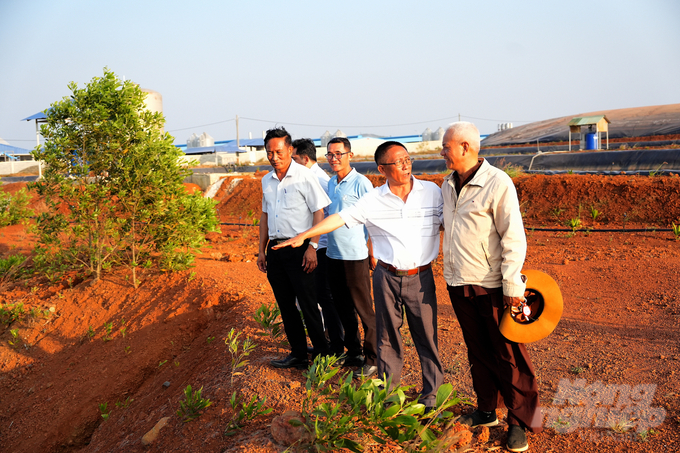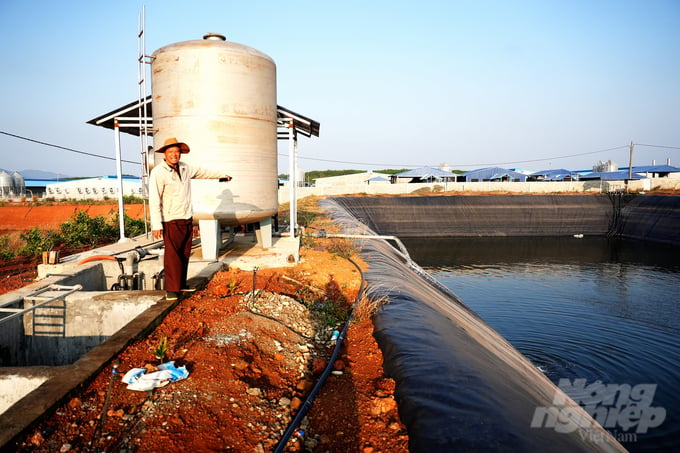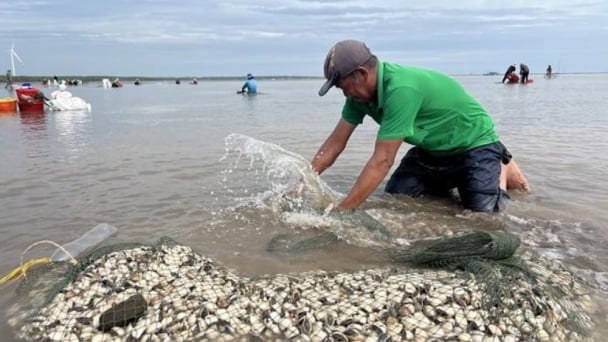May 29, 2025 | 16:22 GMT +7
May 29, 2025 | 16:22 GMT +7
Hotline: 0913.378.918
May 29, 2025 | 16:22 GMT +7
Hotline: 0913.378.918

Mr. Vu Van Khang (second from right), Director of Khang Tho Co., Ltd., welcomed us outside the pig farm gate. Photo: Hong Thuy.
Khang Tho Company Limited's 48,000 pig farm in Phu Hoa village, Quang Phu commune, Krong No district, Dak Nong province. The farm has just been completed and has been in operation for more than a year, and is currently raising its third batch of pigs.
Khang Tho Company's gilt farm is located separately on low hill land, far from residential areas. The total area is 112 hectares, of which the livestock area and pig barns are more than 25 hectares. A 2m high wall surrounds the entire farm.
Around the wall is a 5km long internal road invested by the Company for transportation. The car drove on this road for about 10 minutes before reaching the main gate leading into the camp. Even though right inside the wall were thousands of pigs, the environment was still relatively fresh, not polluted with bad odors as usual. Khang Tho livestock farm was inaugurated in February 2022. After being granted an environmental license, the Company completed the first batch with 48,100 heads and is raising the 3rd batch.
Welcoming us right at the farm gate, Mr. Vu Van Khang, Director of the Company, said that we could only stand outside and talk but could not go inside the farm.

Control system for waste treatment area of Khang Tho pig farm. Photo: Hong Thuy.
This is a cold farm model, but the pigs are dry, meaning the pigs do not bathe. As for technology, there are some new improvements in barns, waste paths, processes, and technology that are a bit different from the long-standing models applied by livestock corporations.
"As here, the barn is designed with two floors: the upper floor is where the pigs live, the lower floor contains water, the depth is about 40cm, the distance between the bottom where the pigs live, and the water surface is about 40cm, the floor of the pig cage is made from thick steel woven panels, there is a hole for waste to fall into the water below. The waste tank combines several solutions and microbial products to treat odors and compost the manure.
The next stage in the waste treatment process is separating feces and wastewater separately. Water flows into the biogas tank for further processing to be released into the environment. At the same time, solid waste will be composted into organic fertilizer using Korean technology with a moisture content of 25-30%," Mr. Khang continued.

Mr. Ho Gam (second from right), Chairman of the Dak Nong Provincial Farmers' Association, was very excited to see this modern livestock farm with his own eyes. Photo: Hong Thuy.
According to Mr. Khang, for pig farms, odor and wastewater treatment are the two most important issues. “If I can't handle waste and environmental issues, I won't do it. Because that is one of the mandatory requirements. It is impossible for personal purposes to affect the community or pollute the environment. Therefore, the Company has invested tens of billions of VND in a wastewater treatment system using the most modern European technology, combining three biological, physical and physicochemical methods.
The pig farm's daily water use demand is more than 1,000m3, of which more than 700m3 of water directly serves livestock activities. To treat this large volume of water to environmental standards, the farm has invested in 3 biogas tanks, using a disturbance system with anaerobic microorganisms to decompose highly polluted organic substances effectively. The processing capacity of the entire biogas system reaches 800m3 day/night. Next to each tunnel, there is a 2,000 square meter wastewater reservoir," Mr. Khang said.
The biggest difficulty of the farm is that there is no underground water and cannot drill wells. Therefore, he had to invest in a rainwater reservoir and a high-capacity pump system, along with thousands of meters of pipes to pump water from a stream quite far away to serve livestock.

Mr. Vu Van Khang: "This wastewater lake released into the environment is stocking some fish." Photo: Hong Thuy.
To demonstrate, Mr. Khang took us to each wastewater pond. In the first treatment pond, the water was black and smelly. In the second pond, the water was clearer, and the odor was completely reduced. And in the last lake, the wastewater is completely clean. I took a cup of the pump's nozzle and brought it up to my nose to smell it, but I didn't feel any smell. Pointing at the lake water discharged into the environment, Mr. Khang said: "This water is like a river or stream. I am raising some types of trash fish down there."
After the Khang Tho pig farm was completed, many households around the area benefited. Mr. Khang said the company has invested billions of dong to bulldoze and build a concrete road running around the company wall. Thanks to that, many households have a clean road to walk on.
In addition, this area still has many households near the farm that do not have grid electricity. Khang Tho Company has invested in low-voltage power lines from the high-voltage power system on the road, 5-6 kilometers away, to serve livestock farming and electricity support for households near the farm.
Translated by Tuan Huy

(VAN) FAO’s Director-General addresses the 5th Baghdad International Water Conference.
/2025/05/26/1716-4-nongnghiep-191706.jpg)
(VAN) Chain linkages, technological innovation, and raw material zoning are three strategic pillars for the coconut industry to strongly develop and elevate its position on the global agricultural map.
![Advanced mariculture – an inevitable trend: [4] Accompanied by scientists](https://t.ex-cdn.com/nongnghiepmoitruong.vn/608w/files/sohk/2025/05/13/1941-pgsts-vo-van-nha-140958_717.jpg)
(VAN) According to Assoc. Prof. Dr. Vo Van Nha, Director of the RIA III, the development of advanced offshore mariculture is no longer an option but an essential path for Vietnam’s fisheries sector.

(VAN) Vietnam is intensifying the development of mollusk farming areas that meet international standards, aiming for sustainable growth and enhancing its export position in the global seafood market.
![Advanced mariculture – an inevitable trend: [3] Policy-driven momentum](https://t.ex-cdn.com/nongnghiepmoitruong.vn/608w/files/doanhtq/2025/05/21/0104-0616-0348-nuoi-bien-170339_789.jpg)
(VAN) To ensure the success of offshore mariculture that uses advanced technologies, it is essential to establish supportive policies that inspire both individuals and enterprises to invest with confidence.
![Advanced mariculture – an inevitable trend: [2] Outstanding results](https://t.ex-cdn.com/nongnghiepmoitruong.vn/608w/files/sohk/2025/05/12/4632-4136-nuoi-bien-11-164117_819.jpg)
(VAN) Pilot models of high-tech offshore mariculture in Vietnam, particularly in the South Central Coast region, have demonstrated exceptional economic returns and sustainability, setting a new direction for the country’s aquaculture industry.
![Advanced mariculture – an inevitable trend: [1] Moving offshore](https://t.ex-cdn.com/nongnghiepmoitruong.vn/608w/files/phucpm/2025/05/18/0252-2436-nuoi-bien-6-162148_783.jpg)
(VAN) Mariculture using advanced technology and moving offshore is an inevitable trend, as nearshore areas increasingly reveal limitations.